turn signal Citroen DS3 2014 1.G Owner's Manual
[x] Cancel search | Manufacturer: CITROEN, Model Year: 2014, Model line: DS3, Model: Citroen DS3 2014 1.GPages: 376, PDF Size: 12.55 MB
Page 37 of 376
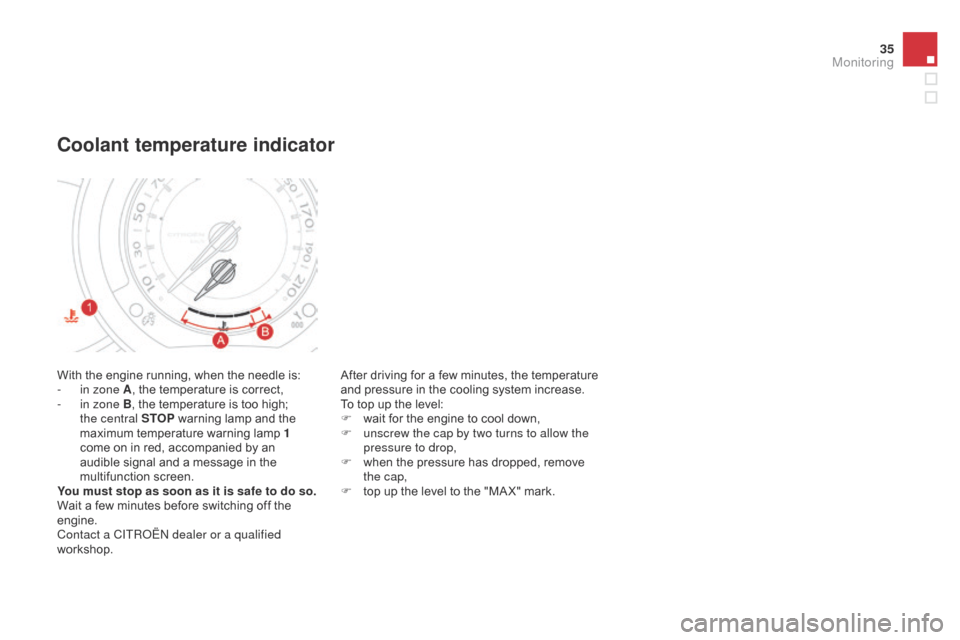
35
DS3_en_Chap01_controle-de-marche_ed01-2014
With the engine running, when the needle is:
- i n zone A ,
the temperature is correct,
-
i
n zone B, the temperature is too high;
t
he central STOP
warning lamp and the
m
aximum temperature warning lamp 1
come
on in red, accompanied by an
a
udible signal and a message in the
m
ultifunction
s
creen.
You must stop as soon as it is safe to do so.
Wait
a few minutes before switching off the
e
ngine.
Contact a CITR
oË
N dealer or a qualified
workshop.
coolant temperature indicator
After driving for a few minutes, the temperature a nd pressure in the cooling system increase.
To
top up the level:
F
w
ait for the engine to cool down,
F
u
nscrew the cap by two turns to allow the
pressure to drop,
F
w
hen the pressure has dropped, remove
t
he cap,
F
t
op up the level to the "MA X" mark.
Monitoring
Page 116 of 376
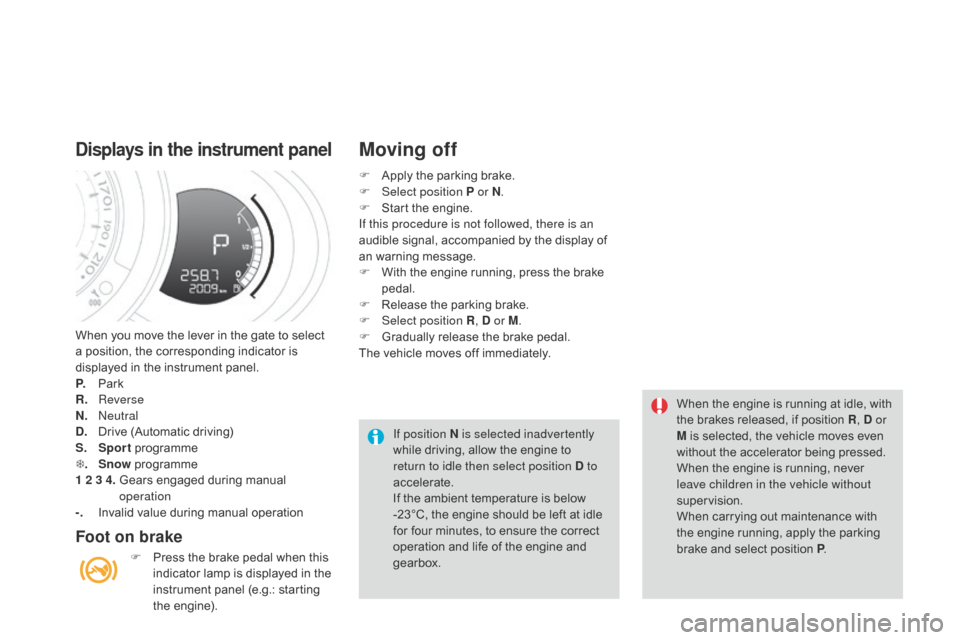
DS3_en_Chap06_conduite_ed01-2014
When you move the lever in the gate to select a position, the corresponding indicator is
d
isplayed in the instrument panel.
P.
Pa
rk
R.
R
everse
N.
N
eutral
d
.
D
rive (Automatic driving)
S.
Sport
pro
gramme
T .
Snow
pro
gramme
1 2 3 4.
G
ears engaged during manual
ope
ration
-.
I
nvalid value during manual operation
displays in the instrument panel
Foot on brake
F Press the brake pedal when this i
ndicator lamp is displayed in the
i
nstrument panel (e.g.: starting
t
he
eng
ine).
Moving off
If position N is selected inadvertently
while driving, allow the engine to
r
eturn to idle then select position d to
accelerate.
If
the ambient temperature is below
-
23°C, the engine should be left at idle
f
or four minutes, to ensure the correct
o
peration and life of the engine and
g
earbox. When
the engine is running at idle, with t
he brakes released, if position R
, d or
M is selected, the vehicle moves even
w
ithout the accelerator being pressed.
When
the engine is running, never
l
eave children in the vehicle without
supervision.
When
carrying out maintenance with
t
he engine running, apply the parking
b
rake and select position P.
F
A
pply the parking brake.
F
Sel
ect position P or N
.
F
S
tart the engine.
If this procedure is not followed, there is an
audible signal, accompanied by the display of
a
n
warning message.
F
W
ith the engine running, press the brake
ped
al.
F
R
elease the parking brake.
F
Sel
ect position R
, d or M
.
F
G
radually release the brake pedal.
The
vehicle moves off immediately.
Page 118 of 376
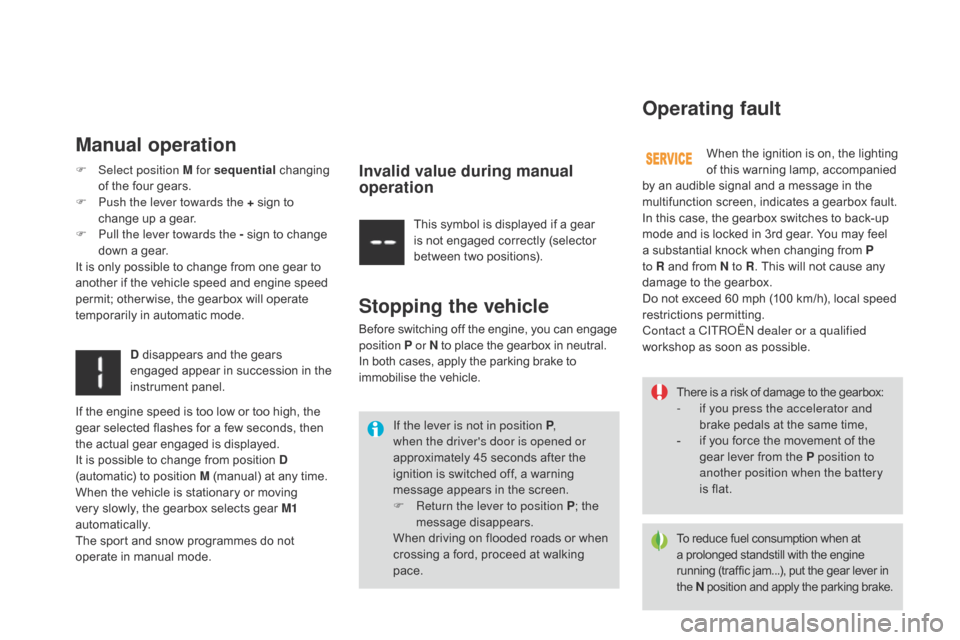
DS3_en_Chap06_conduite_ed01-2014
There is a risk of damage to the gearbox:
- i f you press the accelerator and
brake
pedals at the same time,
-
i
f you force the movement of the
g
ear lever from the P position to
another position when the battery
is
flat.
To
reduce fuel consumption when at
a
prolonged standstill with the engine
r
unning (traffic jam...), put the gear lever in
t
he N
position and apply the parking brake.
If the lever is not in position P
,
when the driver's door is opened or
approximately
45
seconds
after
the
i
gnition
is
switched
off,
a
warning
m
essage
appears
in
the
screen.
F
R
eturn the lever to position P ;
the
m
essage
d
isappears.
When
driving
on
flooded
roads
or
when
c
rossing
a
ford,
proceed
at
walking
p
ace.
Operating fault
Manual operation
When the ignition is on, the lighting o f this warning lamp, accompanied
b
y
an
audible signal and a message in the
m
ultifunction screen, indicates a gearbox fault.
In
this
case, the gearbox switches to back-up
m
ode
and
is locked in 3rd gear. You may feel
a
substantial knock when changing from P
to R
and
from N to R .
This will not cause any
d
amage
to
the gearbox.
Do
not
exceed 60 mph (100 km/h), local speed
r
estrictions
p
ermitting.
Contact a CITR
oË
N dealer or a qualified
workshop
as soon as possible.
F
Sel
ect position M for sequential
c
hanging
o
f
the
four
gears.
F
P
ush the lever towards the +
sign
to
c
hange
up
a
gear.
F
P
ull the lever towards the -
sign
to
change
d
own
a
gear.
It
is
only
possible
to
change
from
one
gear
to
a
nother
if
the
vehicle
speed
and
engine
speed
p
ermit;
other wise,
the
gearbox
will
operate
t
emporarily
in
automatic
mode. This
symbol
is
displayed
if
a
gear
i
s
not
engaged
correctly
(selector
b
etween
two
positions).
d
disappears
and
the
gears
e
ngaged
appear
in
succession
in
the
in
strument
pan
el.
Stopping the vehicle
Before switching off the engine, you can engage p osition P or N
to place the gearbox in neutral.
In
both cases, apply the parking brake to
i
mmobilise the vehicle.
Invalid value during manual
operation
If the engine speed is too low or too high, the gear selected flashes for a few seconds, then
t
he actual gear engaged is displayed.
It
is possible to change from position d
(automatic)
to position M (manual) at any time.
When
the vehicle is stationary or moving
v
ery slowly, the gearbox selects gear M1
automatically.
The
sport and snow programmes do not
o
perate in manual mode.
Page 138 of 376
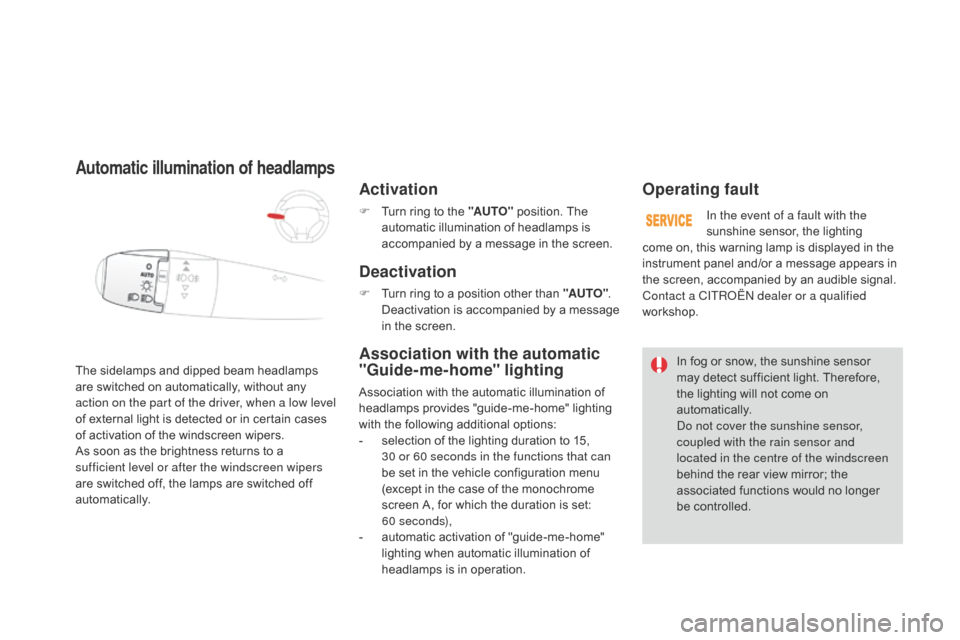
DS3_en_Chap07_visibilite_ed01-2014
The sidelamps and dipped beam headlamps are switched on automatically, without any
a
ction on the part of the driver, when a low level
of
external light is detected or in certain cases
o
f activation of the windscreen wipers.
As
soon as the brightness returns to a
s
ufficient level or after the windscreen wipers
are
switched off, the lamps are switched off
au
tomatically.
Automatic illumination of headlamps
Activation
F Turn ring to the "AUTO" position. The a
utomatic illumination of headlamps is
a
ccompanied by a message in the screen.
deactivation
F Turn ring to a position other than "AUTO". D
eactivation is accompanied by a message
i
n the screen.
Association with the automatic
"Guide-me-home" lighting
Association with the automatic illumination of headlamps provides "guide-me-home" lighting
w
ith the following additional options:
-
s
election of the lighting duration to 15,
30 or 60 seconds in the functions that can
be
set in the vehicle configuration menu
(
except in the case of the monochrome
s
creen A, for which the duration is set:
60 seconds),
-
a
utomatic activation of "guide-me-home"
l
ighting when automatic illumination of
h
eadlamps is in operation.
Operating fault
In the event of a fault with the
sunshine sensor, the lighting
c
ome
on,
this warning lamp is displayed in the
i
nstrument
panel and/or a message appears in
t
he
screen,
accompanied by an audible signal.
Contact a CITR
oË
N dealer or a qualified
workshop.
In
fog or snow, the sunshine sensor
m
ay
detect sufficient light. Therefore,
t
he
lighting will not come on
au
tomatically.
Do not cover the sunshine sensor,
coupled with the rain sensor and
located in the centre of the windscreen
behind
the rear view mirror; the
a
ssociated functions would no longer
be c
ontrolled.
Page 199 of 376
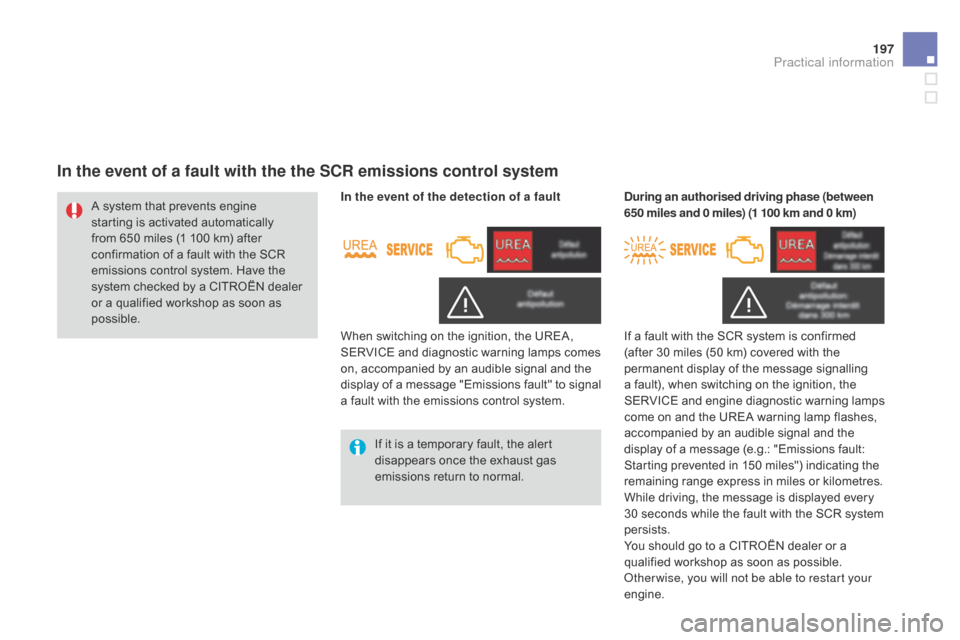
197
DS3_en_Chap10_info-pratiques_ed01-2014
In the event of a fault with the the ScR emissions control system
If it is a temporary fault, the alert d
isappears once the exhaust gas
e
missions return to normal.
A
system
that
prevents
engine
s
tarting
is
activated
automatically
f
rom
650 miles
(1
100
km)
after
c
onfirmation
of
a
fault
with
the
SCR
e
missions
control
system.
Have
the
s
ystem
checked
by
a
CITROËN
dealer
o
r
a
qualified
workshop
as
soon
as
p
ossible.
In the event of the detection of a fault
du
ring an authorised driving phase (between
650 miles and 0 miles) (1 100 km and 0 km)
When
switching on the ignition, the UREA,
S
ERVICE and diagnostic warning lamps comes
o
n,
accompanied by an audible signal and the
d
isplay
o
f
a m
essage
"
Emissions
f
ault"
t
o
s
ignal
a
fault
with the emissions control system.If a fault with the SCR system is confirmed
(
after 30 miles (50 km) covered with the
p
ermanent display of the message signalling
a
fault), when switching on the ignition, the
S
ERVICE
an
d
e
ngine
d
iagnostic
w
arning
lam
ps
c
ome on and the UREA warning lamp flashes, a
ccompanied by an audible signal and the d
isplay of a message (e.g.: "Emissions fault:
S
tarting prevented in 150 miles") indicating the
r
emaining range express in miles or kilometres.
While
driving, the message is displayed every
3
0 seconds while the fault with the SCR system
p
ersists.
You
should go to a CITROËN dealer or a
q
ualified workshop as soon as possible.
ot
her wise, you will not be able to restart your
engine.
Practical information
Page 203 of 376
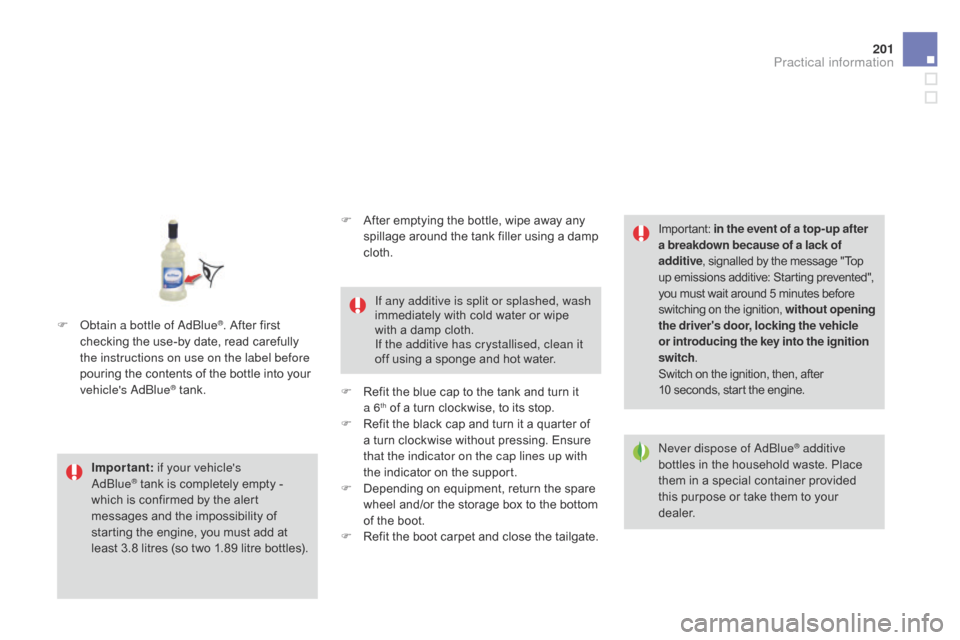
201
DS3_en_Chap10_info-pratiques_ed01-2014
Important: if your vehicle's a
dblu e® tank is completely empty - w
hich
is
confirmed by the alert
m
essages and the impossibility of
s
tarting
the engine, you must add at
l
east
3.8 litres (so two 1.89 litre bottles).If any additive is split or splashed, wash
immediately
with cold water or wipe
w
ith a damp cloth.
If the additive has crystallised, clean it
off using a sponge and hot water.Important:
i
n the event of a top-up after
a breakdown because of a lack of
additive , signalled by the message "Top
u
p emissions additive: Starting prevented",
y
ou must wait around 5 minutes before
s
witching
o
n
t
he
i
gnition,
w
ithout opening
the driver's door, locking the vehicle
or introducing the key into the ignition
switch .
Switch on the ignition, then, after
1
0 seconds, start the engine.
F
o
b
tain a bottle of a
dbl
ue
®. After first c
hecking
the
use-by
date,
read carefully
t
he instructions on use on the label before
pouring
the
contents
of
the bottle into your
v
ehicle's
a
d
blu
e
® tank. N ever dispose of a
dbl
ue
® additive
bottles
in
the
household
waste. Place
t
hem
in
a
special
container provided
t
his
purpose
or
take
them
to your
d
ealer.
F
A
fter
emptying
the
bottle,
wipe
away
any
s
pillage
around
the
tank
filler
using
a
damp
c
loth.
F
R
efit
the
blue
cap
to
the
tank
and
turn
it
a
6
th of a turn clockwise, to its stop.
F
R
efit the black cap and turn it a quarter of
a
turn clockwise without pressing. Ensure
t
hat the indicator on the cap lines up with
the
indicator on the support.
F
D
epending on equipment, return the spare
w
heel and/or the storage box to the bottom
o
f
the boot.
F
R
efit the boot carpet and close the tailgate.
Practical information
Page 317 of 376
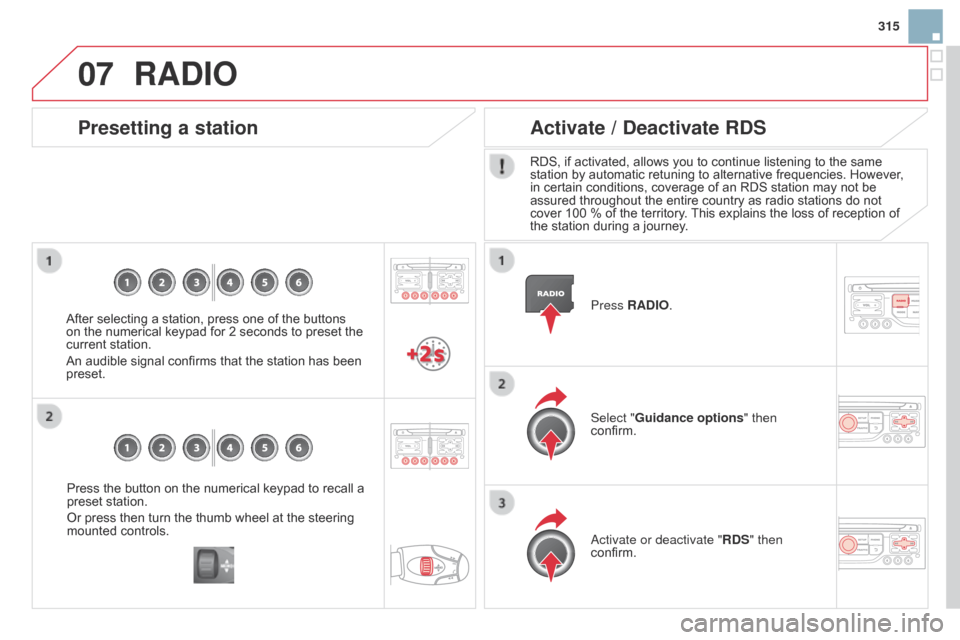
07
315
DS3_en_Chap13b_RT6-2-8_ed01-2014
Press the button on the numerical keypad to recall a preset station.
Or
press then turn the thumb wheel at the steering
mounted
controls.
Presetting a station
After selecting a station, press one of the buttons on the numerical keypad for 2 seconds to preset the
current
station.
An
audible signal confirms that the station has been
preset. Press
RA d IO.
Activate / d
eactivate R d S
RDS, if activated, allows you to continue listening to the same station
by automatic retuning to alternative frequencies. However,
in
certain conditions, coverage of an RDS station may not be
assured
throughout the entire country as radio stations do not
cover
100 % of the territory.
This
explains the loss of reception of
the
station during a journey.
Select "Guidance options " then
confirm.
a
ctivate or deactivate "R d S" then
confirm.
RAdIO